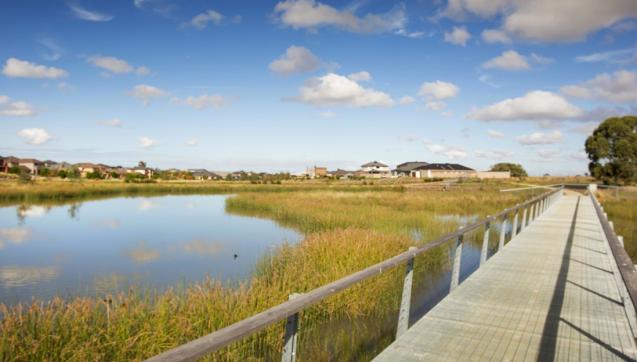Melbourne’s drainage system directs stormwater away from urban areas to reduce the risk of flooding. While it can handle most storms, extreme rainfall can still sometimes cause floods.
The drainage system is made up of:
- 1,400 kilometres of regional drains, managed by Melbourne Water
- 25,000 kilometres of local drains and street gutters, managed by councils
- building roof gutters, downpipes and pipelines, which are the responsibility of property owners
- other drains managed by agencies like VicRoads and VicTrack.
Understanding drainage systems – transcript (69KB, PDF)
The journey of stormwater
When it rains, some water naturally seeps into the ground. To keep the rest of it away from properties, the drainage system channels it into rivers and creeks – and eventually into the bays.
Household gutters and drains
Water first enters house gutters and downpipes, flowing into residential drains.
Council drains
Residential drains channel stormwater into larger council drains along roads and footpaths.
Melbourne Water’s regional drains
Council drains connect to Melbourne Water’s regional drainage network, which carries larger water flows.
Creeks and rivers
Regional drains direct stormwater into the nearest river or creek. In some suburbs, water passes through artificial wetlands that are designed to slow down flows and filter out pollutants.
Port Phillip and Western Port bays
Finally, stormwater reaches our bays via rivers or creeks – and sometimes, directly through piped beach outlets.
Managing the drainage system
Together with councils, we work to keep Melbourne’s drainage system functioning by:
- Inspecting and maintaining drains by removing rubbish and debris that cause blockages.
- Monitoring and operating pump stations, tidal gates and diversion gates to direct water flows.
- Upgrading and building new infrastructure to reduce flood risk as Melbourne grows.
You can help by:
- Keeping gutters and drains clear of debris to avoid blockages.
- Reporting blocked drains to your council or Melbourne Water.
- Installing rainwater tanks or garden features to reduce the amount of stormwater leaving your home.
Staying safe around drains
Entering stormwater drains is illegal, dangerous and sometimes deadly. Water levels can rise quickly without warning, and there may be poisonous gases or hidden slopes where you can fall.
Warning signs are placed at drain entrances across Melbourne.
Why flooding still happens
Our drainage system was designed to cope with most common storms. But intense rainfall can generate more stormwater than our drains can carry – and climate change and urban growth only add to this challenge.
We can’t prevent all flooding by building new drains: it would be too costly and disruptive. Some parts of Melbourne are built on former swampland, and other areas no longer have space for more infrastructure due to existing pipelines and assets.
That’s why we carefully consider any new flood infrastructure to balance economic, environmental and social factors. We prioritise high-risk areas where we can make the most difference, and work with other organisations on a range of approaches to minimise flood impacts.
